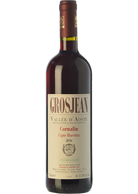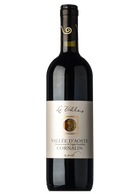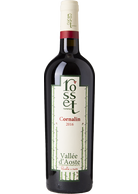Cornalin
A native Valdostan grape variety, the cornalin would correspond to the humagne rouge of the Valais, where it was introduced around the 1940s or, more probably, at the end of the 1800s: it is in fact considered, in the same way, one of the main Swiss red native species. In Valle d'Aosta it has always had a scattered diffusion, concentrated in the areas of Saint-Vincent and Verrayes. It is currently in the recovery phase, even if it is certainly among the regional "minors" and is certainly one of the best exposed and most convincing expressions. The grapes from the vineyards of the area produce a fine wine, purplish red in colour, veering to garnet with maturation and refinement; the fine and very intense fragrance is reminiscent of spices (pepper and vanilla) and some aromatic essences (thyme, tobacco); if well aged, the taste is soft, full, pleasantly tannic, with excellent balance and persistence.

Cornalin
A native Valdostan grape variety, the cornalin would correspond to the humagne rouge of the Valais, where it was introduced around the 1940s or, more probably, at the end of the 1800s: it is in fact considered, in the same way, one of the main Swiss red native species. In Valle d'Aosta it has always had a scattered diffusion, concentrated in the areas of Saint-Vincent and Verrayes. It is currently in the recovery phase, even if it is certainly among the regional "minors" and is certainly one of the best exposed and most convincing expressions. The grapes from the vineyards of the area produce a fine wine, purplish red in colour, veering to garnet with maturation and refinement; the fine and very intense fragrance is reminiscent of spices (pepper and vanilla) and some aromatic essences (thyme, tobacco); if well aged, the taste is soft, full, pleasantly tannic, with excellent balance and persistence.


